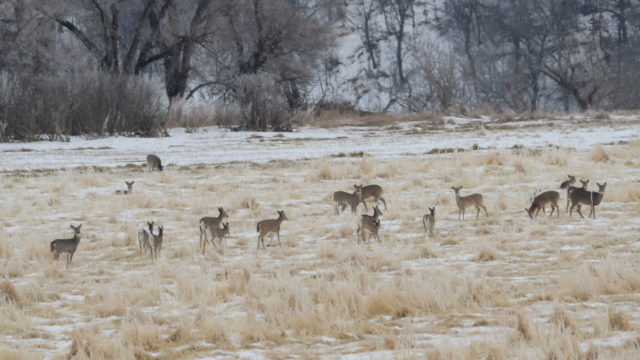Guest Post: The reality of winter and wildlife

Guest post from North Dakota Game & Fish outreach biologist Doug Lier.
When the phone rings or the inbox pings, it’s reminiscent of unwrapping a Christmas present. I literally have no idea what’s behind the rings and pings. It’s one part of my job that truly keeps me on my toes and I enjoy it.
Questions about regulations, to the hottest fishing bite, or simply a random wildlife observation, I just never know what’s coming.
As the saying goes, I truly believe there’s no such thing as a silly question. There isn’t. The phone conversations allow for a more natural flow and context with the emotion, an important aspect in understanding where the caller is coming from.
I had a call about an injured goose early this winter and after explaining how the goose doesn’t want to be captured and risking a human life to shimmy across thin ice isn’t something I’d suggest. If a human was being rescued, you wouldn’t expect them to try to bite you. A goose or any animal is most likely going to see you as a threat and defend itself or escape.
Watching a goose or deer suffer from injury, sickness or disease isn’t for the faint of heart. But it happens. It’s nature and as I’ve explained, nature is more PG-13 or rated “R” for violence than G.
So, it goes with feeding wildlife in winter, even during a mild winter. North Dakota Game and Fish Department biologists are asked about feeding wildlife, and quite frankly, most of the people I talk to don’t want to hear the answer.
The components – food, water, shelter and space – needed to sustain wildlife through a harsh Midwest winter have not changed and remain same.
For concerned humans, food and water for wildlife were more easily provided, while cover and space were more time-consuming and costly and thus not considered as easy or economical to put into practice. In fact, many people felt that providing additional winter food would compensate for a general lack of adequate winter cover and space.
Even the mildest of North Dakota winters have periods of extreme cold that threaten some wild animals. Pheasants and even songbirds are found dead with full crops, succumbing to snow and cold, even when feeders are full. Over time, it has become evident that more than food was needed to improve winter wildlife survival.
But what you don’t see if you’re not watching all the time is that when deer are drawn out of suitable cover and artificially concentrated around corn piles and alfalfa bales, the natural pecking order keeps needed nutrients from young of the year, which can possibly lead to increased mortality even if adequate feed is provided. The big and strong act like the class bully when the piñata breaks, hording the goodies while the others struggle for even a morsel.
A couple years back, a friend was enjoying the rabbits in his back yard feeding on some scattered grain. Not long after when I asked for a status update, he related the rabbits had shrunk in number and he figured the reason was a coyote that was taking advantage of his “helping” the rabbits.
This is a good example of a well-intentioned decision that perhaps caused more harm than good, and it helps summarize the current developing theory on feeding: It may be good for an
individual or a few animals, but it does little for the overall health of a species and in some cases can actually make things worse.
The bottom line is that natural food plots, with suitable winter cover nearby, is best for wildlife management.
That comes from a balanced natural mix of food, water, shelter and space. That’s the best recommendation given the research and knowledge we’ve got to work with.




